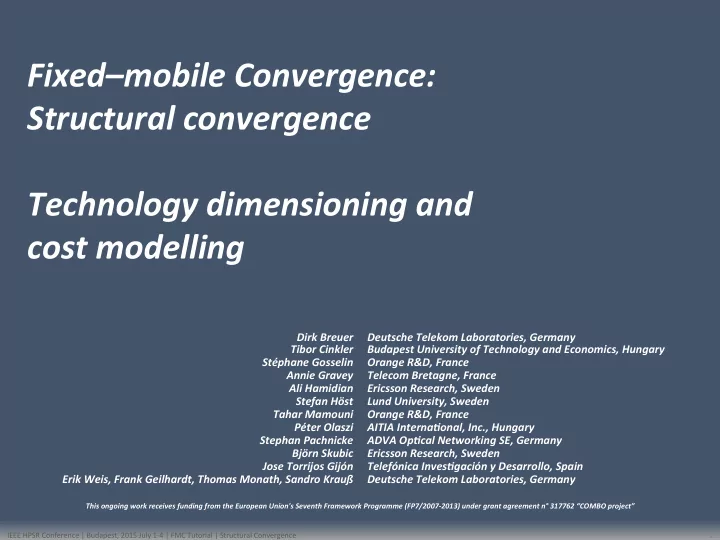

Fixed–mobile Convergence: Structural convergence Technology dimensioning and cost modelling Dirk Breuer Deutsche Telekom Laboratories, Germany Tibor Cinkler Budapest University of Technology and Economics, Hungary Stéphane Gosselin Orange R&D, France Annie Gravey Telecom Bretagne, France Ali Hamidian Ericsson Research, Sweden Stefan Höst Lund University, Sweden Tahar Mamouni Orange R&D, France Péter Olaszi AITIA Internaeonal, Inc., Hungary Stephan Pachnicke ADVA Opecal Networking SE, Germany Björn Skubic Ericsson Research, Sweden Jose Torrijos Gijón Telefónica Invesegación y Desarrollo, Spain Erik Weis, Frank Geilhardt, Thomas Monath, Sandro Krauß Deutsche Telekom Laboratories, Germany This ongoing work receives funding from the European Union's Seventh Framework Programme (FP7/2007-2013) under grant agreement n° 317762 “COMBO project” IEEE HPSR Conference | Budapest, 2015 July 1-4 | FMC Tutorial | Structural Convergence 1 1
Geo model – key parameters Mobile site Home Building Central Office (CO) Mobile Core Node Main CO Study range Numbers per Main CO area Distances Ultra Ultra Sub- Sub- dense dense Urban Rural Urban Rural urban urban urban urban Avg. number of COs 1 2.9 5.9 10.8 Distances BS ↔ CO Avg. Main CO area size 2 km² 15 km² 142 km² 615 km² Avg. 0.5 km 1.5 km 2.5 km 3.5 km Avg. number of buildings 2,440 6,850 20,400 22,000 Max. 2 km 3 km 4 km 5 km Avg. number of homes 15,820 44,500 51,000 33,000 Distances CO ↔ Main CO Avg. number of cabinets 100 285 380 325 Avg. - 1.9 km 5.9 km 15.6 km Avg. Macro BS density 4 / km² 1.5 / km² 0.2 / km² 0.05 / km² Max. - 10 km 30 km 50 km Avg. number of Macro BS 8 23 29 31 Number of public outdoor SC* * Public indoor small cells to be considered addi_onally if needed Min. case (3 per Macro BS) 24 69 87 Med. case (10 per Macro BS) 80 230 290 0 Max. case (30 per Macro BS) 240 690 870 IEEE HPSR Conference | Budapest, 2015 July 1-4 | FMC Tutorial | Structural Convergence 2 2
Required Backhaul bandwidth for a typical macro site Data traffic S1 per macro site* Co-ordina_on traffic X2 between sites* Assump_on on X2 traffic: 50 Mb/s base rate + 0.3 x S1 traffic Considered for dimensioning example: Macro BS: 40 MHz with 4x4 MU-MIMO = 830 Mbps per macro base sta_on • Small cell Var.1: 20 MHz with 2x2 MIMO = 245 Mbps per small cell • Small cell Var.2: 40 MHz with 4x4 MIMO = 830 Mbps per small cell • MIMO and larger spectrum as well as addi_onal X2 traffic drive the need for >1G backhaul links *According to NGMN backhaul dimensioning rules: backhauling with peak data rate of one sector is sufficient for a site IEEE HPSR Conference | Budapest, 2015 July 1-4 | FMC Tutorial | Structural Convergence 3 3
Fronthaul – LTE-A data rate of radio interface as funceon of radio bandwidth & antennas Considered for dimensioning example: LTE-A Macro BS: 40 MHz with 4x4 MIMO = 10 Gbps per sector → 3 CPRI links per MBS (Daisy chaining of 2 frequency carriers per sector each 20MHz / 5 Gbps) GSM/UMTS Macro BS: 1 Gbps for three GSM sectors and 3 Gbps for three UMTS sectors → 2 CPRI links per MBS (Daisy chaining of 3 sectors per technology) LTE-A Small cell Var.1: 20 MHz with 2x2 MIMO = 2.5 Gbps per sector 1 CPRI link per SC each LTE-A Small cell Var.2: 40 MHz with 4x4 MIMO = 10 Gbps per sector CPRI data rate scales linear with number of antennas and radio bandwidth! IEEE HPSR Conference | Budapest, 2015 July 1-4 | FMC Tutorial | Structural Convergence 4 4
Presented by Annie Gravey annie.gravey@telecom-bretagne.eu Péter Olaszi peter.olaszi@aiea.ai Björn Skubic bjorn.skubic@ericsson.com Dirk Breuer Deutsche Telekom Laboratories, Germany Tibor Cinkler Budapest University of Technology and Economics, Hungary Stéphane Gosselin Orange R&D, France Annie Gravey Telecom Bretagne, France Ali Hamidian Ericsson Research, Sweden Stefan Höst Lund University, Sweden Tahar Mamouni Orange R&D, France Péter Olaszi AITIA Internaeonal, Inc., Hungary Stephan Pachnicke ADVA Opecal Networking SE, Germany Björn Skubic Ericsson Research, Sweden Jose Torrijos Gijón Telefónica Invesegación y Desarrollo, Spain This ongoing work receives funding from the European Union's Seventh Framework Programme (FP7/2007-2013) under grant agreement n° 317762 “COMBO project” IEEE HPSR Conference | Budapest, 2015 July 1-4 | FMC Tutorial | Structural Convergence 5 5
Recommend
More recommend